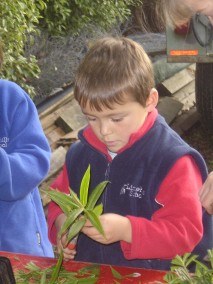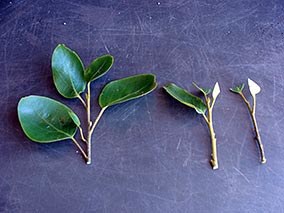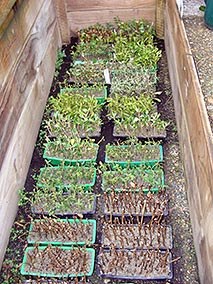Many of Southland’s native trees and shrubs can be grown from cuttings. Sometimes it’s quicker and easier to grow what you want from cuttings rather than growing from seed. Find out more about growing from cuttings.
What you’ll need
 Basic equipment for growing from cuttings.To grow your own native plants from cuttings you’ll need the following:
Basic equipment for growing from cuttings.To grow your own native plants from cuttings you’ll need the following:
- Fresh cutting material.
- Sharp, clean secateurs.
- Rooting hormone – special plant hormone that promotes root growth.
- Seed trays.
- River gravel/sharp sand.
- Labels and pens (permanent).
- Enclosed protective frame with plastic or glass top.
- Watering can.
Before you start
Before you start taking cuttings, remember to:
- Take cuttings in the middle of winter (June/July).
 Limehills School children learn how to take cuttings.
Limehills School children learn how to take cuttings. - Take cuttings from several plants of one species to ensure greater genetic variation (unless you want a ‘clone’ of a particular plant).
- Take cuttings from healthy plants.
- Take short side shoots rather than the rapidly growing terminal shoots.
- Always use clean, sharp secateurs.
- Keep cuttings cool and moist at all times.
Types of cuttings
There are three types of cuttings you can take:
- Hardwood – taken from mature woody stems that grew the previous season.
- Semi-hardwood – taken from partially mature stems.
- Softwood – taken from soft, new growth.
Most cuttings of native plants are semi-hardwood cuttings taken during their dormant period in June/July. Look out for our “Cuttings Training Days” under Events.
How to take cuttings
-
 Broadleaf cuttings showing stages to reduce plant material.Choose straight, healthy stems from partially matured wood.
Broadleaf cuttings showing stages to reduce plant material.Choose straight, healthy stems from partially matured wood. - Cut stem just below a leaf node.
- Cut stems 12-15 cm long.
- Leave the young leaves (2 to 4) and tips, but remove rest of leaves with secateurs or scissors. If leaves are large, cut them in half to help reduce moisture loss.
- Make sure cuttings stay cool and damp while you are working with them.
Planting up cuttings
- Fill seed tray almost to the top with river gravel (no nutrients).
 Keep cuttings in cloche or frame until rooted.
Keep cuttings in cloche or frame until rooted. - Flatten the surface.
- Dip cuttings into rooting hormone and place deeply into the river gravel.
- Label with species name and date.
- Water the trays
Place the seed trays in a protected frame, where they are protected from wind and frost. Water at least once a week (you cannot overwater at this stage, when growing in gravel).
Root formation
Cuttings won’t grow roots until spring, usually around September/October. Roots will emerge through the holes in the bottom of the seed tray. Remember not to pull up the cuttings to see if they have grown roots – young roots are fragile and can break easily.
You can use heating to get cuttings to root sooner. However, you’ll need a heated tunnelhouse to raise the plants in before the weather warms up. It’s best to follow nature and pot up your cuttings in spring.
Find out more
Each year we hold cuttings training days in June. Cuttings frame.
Cuttings frame.
Contact us to find out more.
